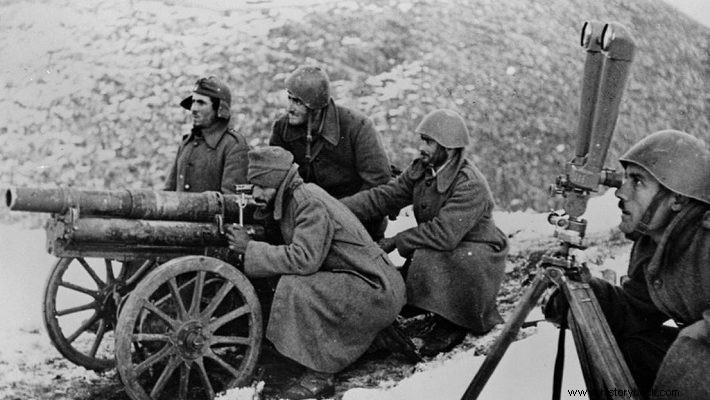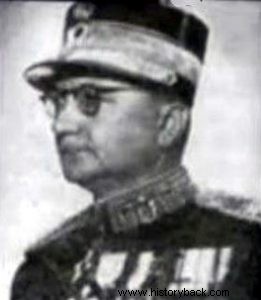
Coming from the Artillery, Lt. General Sotirios Moutousis was born in Achaia in 1894 and died in 1978. He fought in the Balkan Wars, World War I and Asia Minor. However, he particularly distinguished himself in the war of 1940, as the commander of the XIII Infantry Division (MP).
The experienced Moutoussis, the artillery commander of the 3rd Army Corps at the time, assumed command of the Division on 25 November 1940 after the previous command proved unable to carry out the offensive maneuver towards Grabovica and Podgorje as ordered by the Corps. Mutousis, who took over the administration, immediately developed activity.
He immediately moved the 23rd Infantry Regiment (SP) towards Grabovica and covered the front from Episkopi to Podgorije with bodyguards. The same night he sent the II/22nd Infantry Battalion (TP) together with the command of the 22nd SP to Podgorje. Always under his personal supervision, by the evening of the 23rd SP had occupied Grabovica and the surrounding heights and established themselves defensively there.
The Italians offered no resistance, preferring to withdraw to strongly organized positions further north. From the arrangement that Mutousis imposed on his divisions, it was clear that he sought to cover the front from Lake Ahrida to Grabovitsa, which would form the point of connection with the IX MP operating to the south. However, his entire arrangement was rather a cobweb since he had at his disposal only 5 battalions, 3 artillery divisions and 2½ cavalry islands.
However, instead of restricting himself to defense, Moutousis, with the agreement of Tsolakoglou, decided to attack. Its original objective was the breakdown of the nature and art of a fortified enemy location on the west bank of the Tserava River. In the evening, Moutouses informed the commanders of his divisions and at first light on November 26, the 22nd SP with II/22 and III/22TP moved towards heights 955 and 1085. III/23TP occupied the certain positions without serious problems.
The II/22TP, however, occupied 1085 and made contact with a ulama of the 3rd Reconnaissance Group who was acting as a vanguard in the area. In the meantime the Italian forces stopped their retreating maneuver and prepared for defense. Around 10.00 Italian tanks moved along the Cerava – Grabovica road, carrying out offensive reconnaissance.
The Greek units opened massive fire against them and forced them to withdraw. Moutoussis, reflecting on the danger, then reinforced his forces with two field artillery units - of the 3rd 2nd Squadron, assigned to him by the 3rd SS - to which he assigned an anti-tank mission, i.e. the coverage of the Tserava - Grabovitsa carriage road. Further south, the III/23TP reinforced with ulamo (2 guns) of the XIIIa Mountain Artillery Squadron, moved directly west, aiming for hill 1210, which the enemy had fortified and held with strong forces.
The battalion, excellently supported by the two mountain guns overthrew the Italians with a dashing charge with the lance and occupied the hill, also capturing prisoners - including 2 officers - and seizing war material. There the battalion would link up with the 32nd SP of the IX MP. Thus, after Mutousi's intervention, the XIII MP advanced in one day to a depth of 5-7 km inside the enemy location, forming a single front from Episkopi to hill 1210. Essentially, 5 Greek battalions covered more than 10 km of front.
At dawn on November 27, Moutouses ordered the continuation of the attack. He did not mean to lose the initiative of the movements that he had won the previous one for nothing. Disregarding the miserable weather conditions, he advanced his forces, always closely following the fight at its critical points. Moutouses ordered the 2/22TP to move west and capture heights 807 and 975.
However, the battalion was slow to move so the attack was postponed. Immediately the general moved to the area, removed the command from the commander of the 2/22TP and referred him to the military court. In the southern sector of the division, a platoon of the 23rd SP moved aggressively towards the villages of Stroptska and Lesnitsa, which were important Italian strongholds.
The platoon was pinned down by heavy Italian fire, but stuck to the captured positions, not far from their objectives. In the meantime, on the morning of November 27, the 18th SP of the XIII MP, the I/22TP and the XIIIb and XIIIg MOP also arrived in the area with a short wild march. It was the first time that the XIII MP would fight with all its organic divisions, under a single command.
After the unfortunate incident with the 2/22TP, Moutoussis, with his forces now almost at full strength, planned to resume the attack at first light the next day. Besides, during the night the 3rd SS also sent new reinforcements – the XV MOP (6 guns), two 155 thousand artillery pieces and two 13.2 thousand heavy machine gun companies. That night no one slept.
Moutoussis decided to throw his weight on the left flank. His goal was to conquer the height of 1292 – 5km. south of Pogradec. This hill was the key to the Italian site. Its capture would not only open the way to the city, but would also result in the encirclement of 975 Italian forces fighting between Stropska and the hill.
So in the night, the wild and frozen northern continental night, the 18th SP marched again, together with the XIIIth and XV MOP. By 11 a.m. his divisions were deployed on Hill 1210 ready for an advance. During the march, the 18th SP had been bombed by the Italian air force, to no avail. West of the 18th SP the 32nd SP of the IX MP would operate.
Mutousis, as usual, was also there, at the points of departure, on horseback, watching over his units. He personally informed the commander of the 18th SP, colonel Al. Sini and the commanders of the battalions. But the Italians also knew the value of the hill and had fortified it excellently. Machine-gun nests had been set up among the craggy rocks, trenches had been dug, covered with rows of barbed wire, behind were the artillery, having marked fields of fire, and above was the mighty Italian air force.
The conditions were anything but favorable for the Greeks. Nevertheless, the attack took place on the afternoon of November 28, amid miserable weather conditions and snow and fog that limited visibility to 20 meters. The Greek divisions rushed forward and advanced slowly. 2/18TP made contact with the main enemy position of resistance in front of Stropska and 1/18TP in front of the Bragozetti pass (1434). The battalions spent the night in their positions, with express orders to continue the attack at first light the following day, after the friendly artillery had been prepared.
At first light, indeed, the Greek artillery began to hit the enemy positions. But his shot could not be as effective as he would have liked, since the heights occupied by the enemy were covered by thick veils of fog. Thus the Greek infantry failed to advance. The 1/18TP was pinned down, while the commander of the 18th SP, fearing encirclement of the 2/18TP, did not dare to continue the attack with a single battalion. Mutousis, however, was keeping vigil.
Ignoring the excuses, he put himself in charge. Horseman toured the battle lines and ordered the III/18TP, which had been kept in reserve until then, to charge against the enemy. When the III/18TP was ready to set out, Mutousis ordered the regimental adjutant to unfurl the regimental battle flag. The flag, a sacred symbol, in any case, in the midst of battle acquires an even greater importance, as Angelos Terzakis typically mentions (Hellenic Epic 1940-41).
With the flag fluttering in the icy air, with the regimental buglers chanting "advance, advance," the Greek infantry rallied. Officers and men jumped from the trenches and rushed forward. The terrible Greek spears projected menacingly and the sky-long yacht "Aera", covered even the thunder of the cannons.
III/18TP managed to be promoted. He captured most of Stropska, but was then pinned down, coming under fire from his exposed left flank, from well-modified Italian guns. The situation soon became critical, but fortunately the day chief was not idle. An old gunner with vast war experience, from the flashes of the Italian machine guns, in the fog, Moutoussis was able to recognize their positions.
He immediately turned to the commander of XV MOP Captain Voudiklaris and sharply ordered him:"Sir Captain send me a cannon". Immediately the commander's order was carried out and with his personal instructions, with the second shot of a 105 mm mountain gun the Italian machine gun nest was blown into the air!
With his flank clear of enemy machine guns, the 3/18TP now continued his advance and broke through the enemy position in depth, reaching the south of Zevraska and threatening to flank from the right the contested hill 1292.
But the I/18TP also managed to advance and make close contact with the main Italian resistance site before 1292. An even greater feat was achieved by the 2/18TP. A platoon of the battalion roped its way across the craggy banks of the Cereva River between elevations 1210 and 1434 and after regrouping on the north bank and then maneuvering at speed, captured Bragozetti, after a battle with the Italian garrison and made contact with 1292.
The Italian forces on the strategically important high ground were now in danger of being encircled. At first light on 30 November the 3/18TP, under Major Constantinos Malliaros, moved from Zervaska and attacked 1292. At exactly 08.00 the Greek flag was flying on the hill. The Italians suffered an utter defeat on the hill. Their divisions were decimated. Almost an entire company of them was captured while the Greek units captured an entire artillery with its cannons and dozens of machine guns, howitzers, automatics and rifles. It was the end.
The Italian command ordered the immediate disengagement of its forces and the retreat beyond Pogradec. Although Moutoussis, after the capture of 122, ordered all of his forces to advance with the greatest possible speed across the entire width of the front, nevertheless it was not possible to encircle the retreating Italian mass, only the Italian rearguards.
The XIII MP, although it showed weaknesses during the fight, due to the fact that it had a small number of permanent officers and a large number of reservists from the Navy, nevertheless, thanks to the solid and close command of Lt. Gen. Mutousis, it managed to break the Italian front and win the battle of Pogradec.
Opposite it was the Italian MP "Venezia", reinforced with a regiment of elite Versaillese, also possessing a number of tanks and armored vehicles. It is worth noting that Mutousis, when he won the battle of Pogradec, had only 12 days as the commander of the XIII MP. He took over the command during the battle of Ivan – Morava, when the command of the division showed impermissible oligarchy.
However, Mutousis, a bold and experienced warrior himself, did not tolerate any oligarchy. Before and during the battle he replaced six of the division's nine battalion commanders, two regiment commanders and two artillery division commanders. In this way, however, he made the XIII MP, the former Aegean Division, one of the best in the Greek Army.
The epilogue of the war action of the Greek warlord was given a few months later, in April 1941 in Kastoria. The battle of Kastoria – also known as the battle of Argos Orestikos and the battle of Dispilio – was a battle that, based on military logic, should not have even been fought, since the outcome was predetermined and on a strategic level it made no sense, since the Germans was already moving towards Grevena.
However, the battle was fought with stubbornness and fanaticism by the Greeks, from the heroic general S. Moutousis, to the last infantryman, although everyone knew that "the barbarians would eventually pass".

